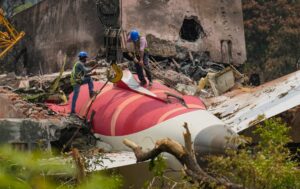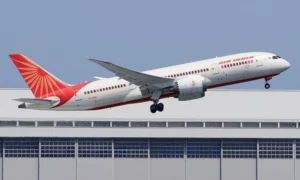“I Didn’t Touch It”: Leaked Audio from Air India Flight 171 and the Deliberate Override Mystery
On June 12, 2025, Air India Flight 171, a Boeing 787-8 Dreamliner en route from Ahmedabad to London Gatwick, crashed 32 seconds after takeoff, killing 260 people—241 passengers and crew onboard and 19 on the ground. The sole survivor, Vishwash Kumar Ramesh, escaped through an emergency exit as the aircraft slammed into a medical college hostel, igniting a 1,500°C fireball. A leaked cockpit voice recorder (CVR) transcript, combined with India’s Aircraft Accident Investigation Bureau (AAIB) preliminary findings, reveals a harrowing sequence: a deliberate override command moved both fuel-control switches to “cutoff” mid-climb, starving the engines, while the co-pilot’s panicked voice exclaimed, “I didn’t touch it.” This article dissects the leaked audio, the evidence of a deliberate act, and the systemic failures that culminated in this tragedy, raising questions about intent, mechanical reliability, and aviation safety.

The Fatal 32 Seconds: A Timeline of Chaos
Flight 171 took off from Ahmedabad’s Sardar Vallabhbhai Patel International Airport at 13:38:39 IST, carrying 230 passengers and 12 crew members. Captain Sumeet Sabharwal, 56, with 15,638 flight hours (8,600 on the 787), was the pilot monitoring, while First Officer Clive Kunder, 32, with 3,403 hours (1,100 on the 787), was the pilot flying. The aircraft reached 180 knots and 650 feet when, at 13:38:42, both fuel-control switches moved to “cutoff” one second apart, cutting fuel to the General Electric GEnx-1B70 engines. The ram air turbine (RAT) deployed instantly, indicating total power loss. The CVR captures Kunder’s desperate cry, “I didn’t touch it,” followed by, “Why did you shut off the engines?” Sabharwal responds, “I didn’t do it.” Ten seconds later, the switches were returned to “run,” initiating an automatic relight. One engine began spooling up, but the aircraft crashed at 13:39:11, after a “Mayday” call went unanswered.
The AAIB’s July 8 report confirms the switches were manually moved, requiring deliberate force to bypass a stop-lock and metal guards. Recent leaks, reported by Corriere della Sera and The Wall Street Journal, suggest a deliberate override command was entered, potentially via the Full Authority Digital Engine Control (FADEC) system or physical switch manipulation. The lack of voice identification in the CVR leaves ambiguity, but U.S. sources point to Sabharwal, as Kunder’s hands were likely on the yoke during climb-out.
The Leaked Audio: Panic and Denial

The CVR transcript, partially leaked via an Italian newspaper, provides timestamps for the critical exchange:
13:38:39 IST: Aircraft lifts off at 180 knots.
13:38:42: Fuel switches move to “cutoff.” Kunder says, “I didn’t touch it,” followed by, “Why did you shut off the engines?” in a panicked tone.
13:38:43: Sabharwal responds, “I didn’t do it,” calmly.
13:38:49: Kunder repeats, “Why did you do it?” for six seconds.
13:38:52: First switch returns to “run.”
13:39:05: “Mayday” call issued.
13:39:11: Crash.
The audio suggests confusion and a lack of coordination, with Kunder’s panic contrasting Sabharwal’s calm denial. The deliberate override command—whether via FADEC input or manual switch movement—implies intentional action, as the switches’ design prevents accidental toggling. Aviation expert Captain Mohan Ranganathan told NDTV, “It has to be manually done… a deliberate manual selection.” However, Captain Kishore Chinta countered, arguing the surprise in Kunder’s voice and Sabharwal’s denial suggest an unexpected event, possibly a system error mislogged as a manual action.
Deliberate Override or System Failure?

The evidence of a deliberate override command has sparked debate. The Wall Street Journal, citing U.S. officials, suggests Sabharwal entered the command, as Kunder was focused on flying. The switches’ physical movement, logged by the Enhanced Airborne Flight Recorder (EAFR), supports this, as does their design requiring intentional force. However, a FADEC glitch, as seen in a 2019 All Nippon Airways 787 incident, could falsely register a cutoff command if sensors misread the aircraft’s state. The AAIB report notes no prior mechanical issues, with fuel samples and maintenance records satisfactory, but the possibility of a software anomaly remains unruled.
The Federation of Indian Pilots (FIP) and ALPA India have criticized media speculation, calling it “reckless” and demanding inclusion in the probe for transparency. The AAIB and NTSB’s Jennifer Homendy have condemned leaks as “premature,” noting the investigation’s complexity. A full report, due by June 2026, is needed to clarify whether the override was human-initiated or a system error.
Systemic Issues: A Broader Failure

Beyond the cockpit, systemic factors contributed:
Switch Design and FADEC Reliability: The 787’s fuel switches require deliberate action, but a 2018 FAA bulletin noted disengaged locking mechanisms on Boeing 737s, raising questions about similar issues. A FADEC glitch could misinterpret sensor data, logging a false manual command.
Cockpit Resource Management (CRM): The CVR shows no standard callouts or verification, indicating a CRM lapse. The pilots’ training records, under review, show both were fit, but the 32-second timeline left no room for recovery.
Investigative Transparency: The AAIB’s selective CVR quotes and lack of voice identification have fueled distrust. Families, like Imtiyaz Ali, who lost relatives, criticize the report’s vagueness.
Safety Culture: Air India’s safety record, including falsified maintenance at Air India Express, and Boeing’s scrutiny post-737 Max, highlight oversight gaps. Cockpit video recorders, opposed by unions, could clarify actions but remain absent.
The Human Cost and Public Reaction
The crash killed 241 onboard, including former Gujarat Chief Minister Vijay Rupani, and 19 ground victims, mostly medical students. Ramesh’s survival, from seat 11A, was miraculous. DNA identification lagged due to the fire’s intensity, with only 35 bodies identified by June 15. Public outrage, amplified on X, focuses on the AAIB’s secrecy and media leaks. Posts by @VishnuNDTV and @WSJ highlight Kunder’s repeated questioning, while @REDBOXINDIA and @PolymarketIntel note U.S. claims against Sabharwal. ALPA India’s Sam Thomas demands observer inclusion to counter bias.
Conclusion: A Search for Truth
The leaked audio from Air India Flight 171, with Kunder’s frantic “I didn’t touch it” and evidence of a deliberate override command, points to a complex tragedy. Was it intentional, a catastrophic error, or a system failure mislogged as human action? The CVR’s ambiguity and the AAIB’s guarded approach leave more questions than answers. As families grieve and the aviation world awaits the final report, systemic reforms—better CRM, robust switch design, and transparent probes—are critical to ensure 260 souls were not lost in vain.



